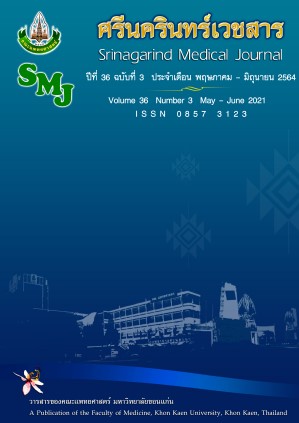การใช้ Real time Tele-Monitoring และการอำนวยการตรงทางการแพทย์ในการส่งต่อผู้ป่วยวิกฤตระหว่างโรงพยาบาล
Abstract
หลักการและวัตถุประสงค์: ทุกโรงพยาบาลชุมชนในจังหวัดขอนแก่นมีระบบ Tele-Monitoring ตั้งแต่ พ.ศ. 2557 หลังจากนั้น 5 ปี ได้มีระบบอำนวยการตรงทางการแพทย์ เพื่อให้คำปรึกษาแก่บุคลากรที่ดูแลผู้ป่วย เป็นการเพิ่มความมั่นใจและทำให้เกิดการตัดสินใจในการช่วยเหลือที่ปลอดภัยต่อผู้ป่วยขณะส่งต่อ การศึกษานี้มีวัตถุประสงค์หลักในการศึกษาความสัมพันธ์ของ Tele-Monitoring ต่อการเสียชีวิตภายใน 24 ชั่วโมงแรก
วิธีการศึกษา: เป็นการศึกษา retrospective cohort ในผู้ป่วยวิกฤตที่ได้รับการส่งต่อมาจากโรงพยาบาลชุมชนจังหวัดขอนแก่น ระหว่างตุลาคม 2561-กันยายน 2562 รายงานผลด้วยสถิติเชิงพรรณนา หาความสัมพันธ์การใช้ Tele-Monitoring และการเสียชีวิตภายใน 24 ชั่วโมงแรกด้วยสถิติไคว์สแคว์ โดยกำหนดระดับนัยสำคัญทางสถิติที่ p<0.05
ผลการศึกษา: มีผู้ป่วยจำนวน 3,750 ราย มีการใช้ Tele-Monitoring ระหว่างการส่งต่อระหว่างโรงพยาบาล 2,867 ราย (ร้อยละ 75.5) อายุเฉลี่ย 61.80±16.58 ปี เพศชายร้อยละ 63.7 และเป็นผู้ป่วยบาดเจ็บร้อยละ 11.1 ข้อบ่งชี้ในการใช้งาน Tele-Monitoring เป็น ESI level 1 พบว่าไม่มีความแตกต่างกันอย่างมีนัยสำคัญของการเสียชีวิตภายใน 24 ชั่วโมงแรก ในกลุ่มที่ใช้และไม่ใช้ Tele-Monitoring (p=0.978)
สรุป: ระบบ Tele-Monitoring สำหรับการส่งต่อผู้ป่วยระหว่างโรงพยาบาลเป็นการลงทุนที่สูง หากมีการเฝ้าสังเกตอย่างใกล้ชิดและมีการใช้ระบบอำนวยการตรงทางการแพทย์จะทำให้ผู้ป่วยได้รับการรักษาอย่างทันท่วงที ลดการเสียชีวิตหรือพิการได้
คำสำคัญ: โทรเวชกรรม; การอำนวยการตรงทางการแพทย์; การส่งต่อผู้ป่วยระหว่างโรงพยาบาล
Background and Objectives: The Tele-Monitoring system has been implemented in all public health hospitals in Khon Kaen Province since 2014. In 5 years later, On-line medical direction program has been initiated to provide real-time consultation for the healthcare personnel during transferring patients. The purposes of the system are to increase the confidence of providers and to enhance the safety management during inter-facility transfer. This study aimed to analyze the association between Tele-Monitoring system used and mortality in first 24 hours.
Methods: It was a retrospective cohort study. The critically ill transferred patients from the rural hospitals to Khon Kaen hospital from October 2018 to September 2019 were enrolled. Descriptive Statistics were used for descriptive data. The association between Tele-Monitoring used and mortality within the first 24 hours was analyzed by Chi-square. P-value <0.05 was set for statistical significance.
Results: There were 3,750 patients enrolled, 2,867 (75.5%) used the Tele-Monitoring system during inter-facility transfer. The mean age was 61.80±16.58 years, male sex was 63.7% and 11.1 % were trauma patients. The most common indication for the Tele-Monitoring used was ESI level 1. The mortality within first 24 hours was not different between Tele-Monitoring used and in non Tele-Monitoring used groups (p=0.978).
Conclusion: The Tele-Monitoring system is a high investment and maintenance of inter-facility. However, the Tele-Monitoring and On-line medical directions will help patients to receive treatment promptly along transferring with reducing death or disability.
Keywords: Telemedicine; On-line medical direction; Inter-facility transfer


